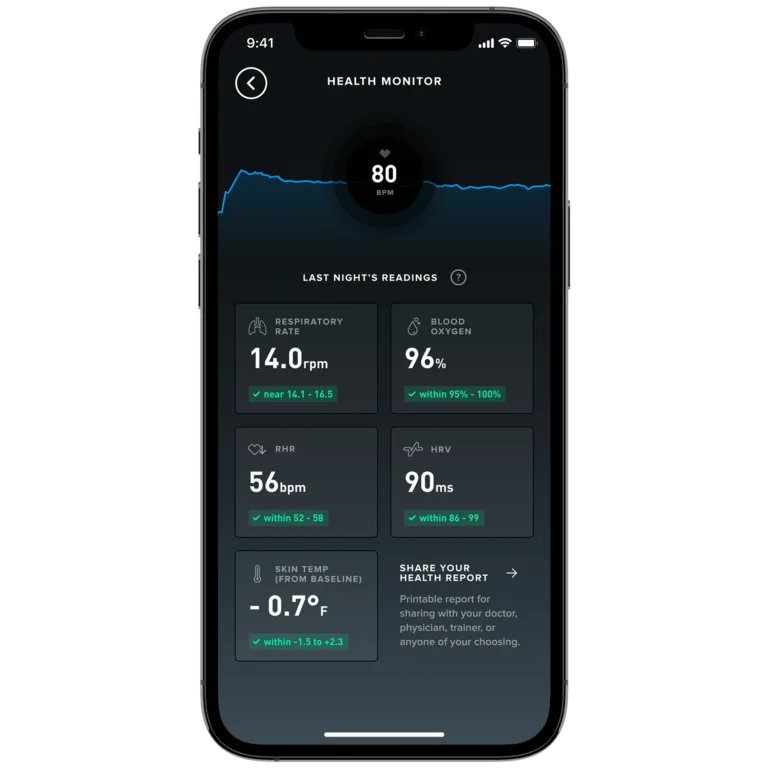Topics
- Article
- Health & Wellness
How to Increase Blood Oxygen Level

We discuss what a healthy blood oxygen level is and share tips for what you can do to improve yours.
Below we’ll explain the basics of your blood oxygen level and why it’s an important metric to track, as well as review potential symptoms of low blood oxygen and suggest some steps you can take to help increase it.
What Does Blood Oxygen Level Mean?
Your blood oxygen level is simply the amount of oxygen present in your blood. The most common method for measuring it is a process called pulse oximetry (more on that later). If your blood oxygen level drops too low, it can be a sign or symptom of various medical issues. In order to function properly, your body requires a constant supply of oxygen. After it is breathed into the lungs, oxygen is transferred to your bloodstream and circulated through your body in red blood cells. Blood oxygen level is an indication of how much oxygen is being distributed to your body by the red blood cells, and maintaining the proper balance of oxygen saturation is very important for your overall health.
What Should Your Blood Oxygen Level Be?
Pulse oximeters read your blood oxygen level by shining light through capillary veins near your skin’s surface. They measure it as a percentage, also referred to as SpO2. A normal blood oxygen level can range from 95-100%. That number is often lower for people with lung diseases or other specific health issues. Blood oxygen levels that fall below 90% are considered quite low. This is called hypoxemia, and may suggest a need to seek medical attention (in particular with cases of COVID-19).
How to Increase Your Blood Oxygen Level
There are a number of things you can do to help boost your blood oxygen level. In the immediate short term:
- Stand or sit up straight. Rather than lying down, which may put pressure on your lungs and make it harder to breathe.
- Cough. If you have a cold or the flu, difficulty breathing can decrease oxygen saturation in your blood. Coughing may loosen up secretions and clear your airway.
- Go outside. Fresh air is good for your lungs and generally has higher levels of oxygen in it. However, if it is very hot or cold out that may hamper your breathing.
- Drink lots of water. Properly hydrated lungs are more efficient at dispersing oxygen into your bloodstream.
- Take slow, deep breaths. This should increase the amount of air going into your lungs.
And on a more long-term basis:
- Practice breathing exercises. Working on deliberate breathing techniques can build up your lung capacity and allow for more oxygen to reach your blood.
- Be active. Physical activity accelerates your breathing rate, enabling you to take in more oxygen. In the same way working out your body improves your fitness, exercising your lungs is good for them too.
- If you smoke, quit. This can rapidly benefit the health of your lungs in a very short time, and to no surprise your blood oxygen level as well.
- Get house plants. Since plants take in carbon dioxide and release oxygen, they freshen the quality of the air you breathe indoors and make it more like what’s outdoors.
- Consume iron-rich foods. Red blood cells need iron, so they may function better (and carry more oxygen through your blood) when you get more iron in your diet.
Symptoms of Low Oxygen Levels in Blood
Possible symptoms of low blood oxygen levels include:
- Shortness of breath
- Heavy breathing
- Chest pains
- Elevated heart rate
- Increased blood pressure
- Dizziness
- Loss of coordination
- Confusion
- Headaches
- Impaired vision
- Cyanosis
Beyond certain medical conditions, low levels of oxygen in your blood can also be the result of changes in your environment--for example, transitioning to a higher altitude where there is a smaller percentage of oxygen in the air.
Track Your Blood Oxygen Level with WHOOP
Most common pulse oximeters track SpO2 from your finger. We implement the same technology to monitor blood oxygen on your wrist, along with a number of other vital signs and key physiological metrics like resting heart rate, heart rate variability, respiratory rate, skin temperature, and sleep. WHOOP calculates your blood oxygen level during sleep each night (when your body is in its most restful state) to ensure the most reliable and consistent readings. You can check your SpO2 each morning via the Health Monitor feature.

The WHOOP Health monitor tracks your blood oxygen level and other valuable physiological metrics.
The products and services of WHOOP are not medical devices, are not intended to diagnose COVID-19, the flu or any other disease, and should not be used as a substitute for professional medical advice, diagnosis or treatment. All content available through the products and services of WHOOP is for general informational purposes only.